Egg Drop Soup Recipe
Egg Drop Soup is a timeless comfort dish rooted in simplicity and elegance, transforming just a few humble ingredients into something warm, nourishing, and visually striking.
With delicate ribbons of silky egg floating in a savory, aromatic broth, this soup delivers both texture and flavor in a soothing, satisfying way.
Its golden hue and gentle fragrance are balanced by subtle notes of garlic, white pepper, and sesame, making each spoonful feel both light and deeply restorative.
Whether served as a starter or a quick, cozy meal, Egg Drop Soup offers a calming experience that bridges tradition and modern comfort with every swirl.
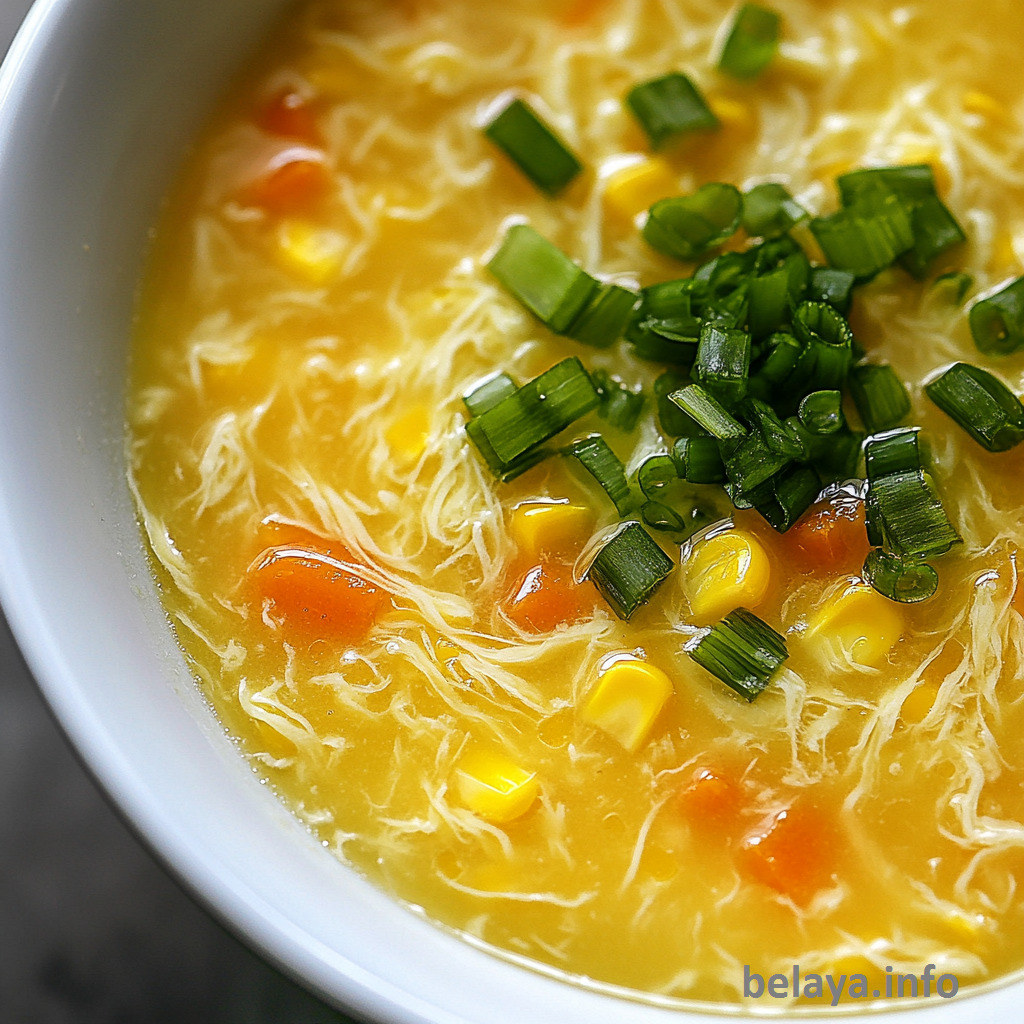
Why People Will Love This Egg Drop Soup:
Comforting and Nourishing: Its warm, savory broth and delicate egg ribbons create a soothing experience that feels both healing and satisfying—perfect for cold days or when you’re feeling unwell.
Beautiful Simplicity: With minimal ingredients and effortless preparation, it delivers elegant results without complexity, making it accessible to cooks of all skill levels.
Velvety, Silky Texture: The signature egg ribbons create a luxurious mouthfeel that contrasts gently with the tender vegetables and fragrant broth.
Customizable Flavor: Whether adding ginger, extra veggies, or spice, this soup adapts to personal tastes while retaining its classic charm.
Wholesome and Light: It’s low in calories but full of depth and nutrition, offering a satisfying option for those seeking balance and nourishment in their meals.
Quick to Prepare: Ready in under 20 minutes, it’s ideal for busy weeknights or when you crave something warm and homemade without a long wait.
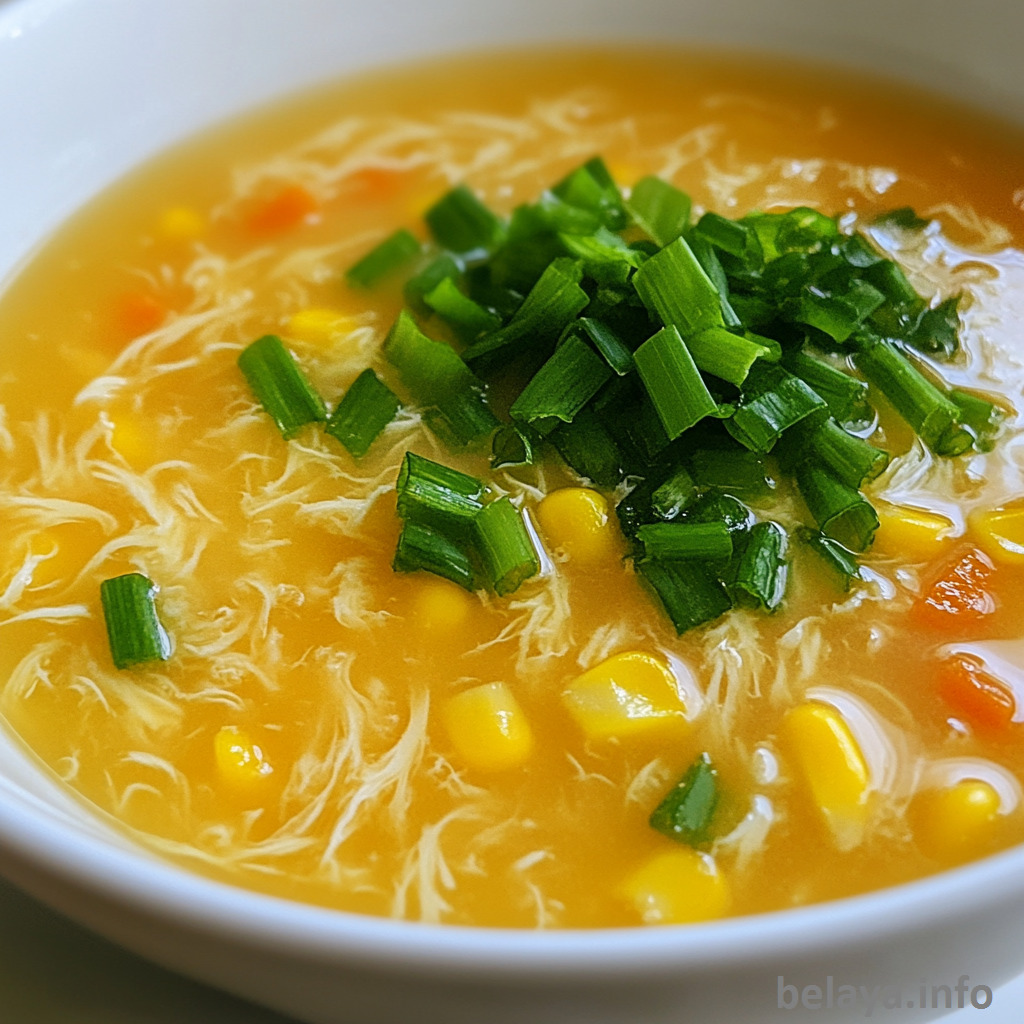
Key Ingredients:
Fresh Eggs: The heart of the dish—beaten until smooth, they form delicate ribbons that float gracefully in the broth, providing protein and a silky texture unique to this soup.
Chicken Stock (or Vegetable Stock): Acts as the flavorful foundation—rich, savory, and aromatic, it carries the warmth and umami depth that defines the soul of the soup.
Garlic: Lightly sautéed in oil, garlic infuses the broth with subtle pungency and warmth, elevating the overall aromatic profile.
Cornstarch Slurry: This simple mix of cornstarch and cold water thickens the soup just enough to give it body and help the egg ribbons suspend beautifully.
Frozen Mixed Vegetables: A convenient blend that adds color, texture, and gentle sweetness—enhancing the soup’s nutritional value without overpowering its delicate flavor.
White Pepper & Toasted Sesame Oil: These final touches bring understated complexity—white pepper for soft heat and aroma, sesame oil for nutty depth and a lingering, savory finish.
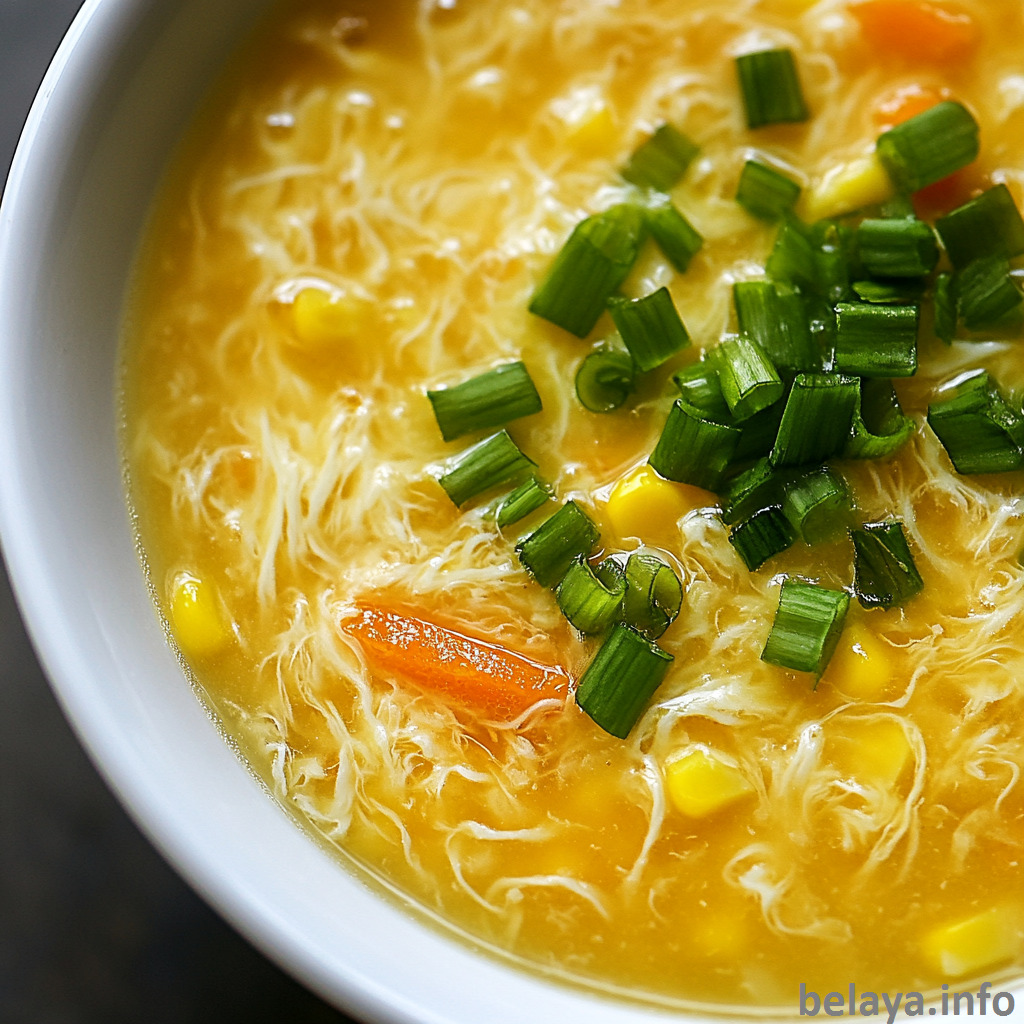
Expert Tips:
Use Fresh, Room Temperature Eggs: Cold eggs can shock the broth and create clumps. Room temperature eggs blend more smoothly and form cleaner, silkier ribbons in the hot soup.
Beat Eggs Thoroughly: Whisk the eggs until they’re completely homogeneous—this ensures consistent texture and smooth streaming, avoiding thick blobs or uneven curds.
Create a Vortex Before Adding Eggs: Stirring the soup in one direction to form a whirlpool before drizzling the eggs helps create long, delicate strands rather than random clumps. Drizzle slowly in a thin stream while the soup is swirling for best results.
Add Slurry Gradually: Cornstarch thickens quickly, so pour the slurry in slowly while stirring to prevent lumps. Wait for it to gently simmer again before adding the eggs for ideal thickness and clarity.
Control the Heat Carefully: Simmer—don’t boil—the soup once the eggs are added. High heat can overcook the eggs, causing them to turn rubbery or cloudy. A gentle simmer allows the ribbons to set beautifully.
Season at the End: Salt and pepper should be adjusted after the eggs have been added, as the eggs can mute or change the perception of saltiness. Add sesame oil just before serving to preserve its aromatic potency.
Strain the Broth (Optional for Clarity): For a more refined, restaurant-style presentation, strain the broth before thickening—this removes bits of garlic and vegetable debris for a cleaner look and smoother base.
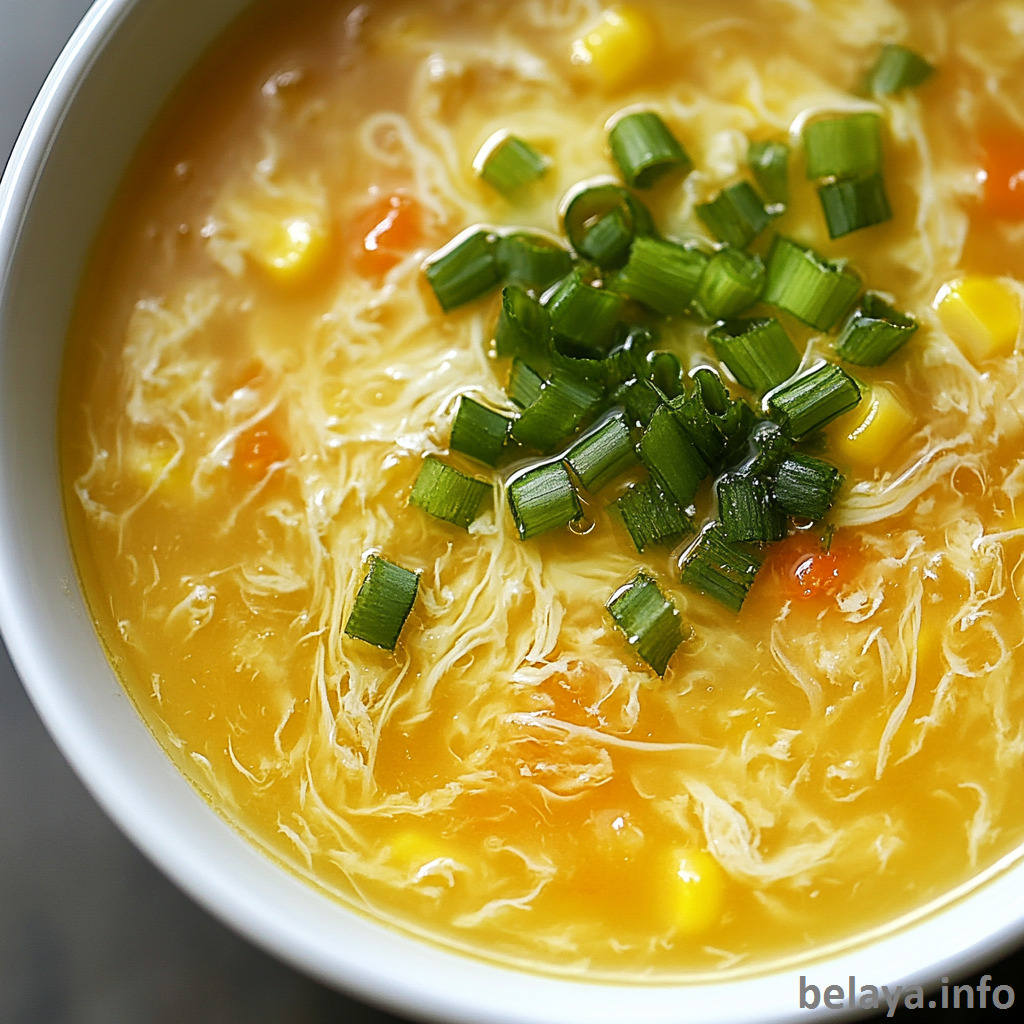
Egg Drop Soup
Ingredients:
For the Egg Ribbons:
3 to 4 large eggs, beaten (use fresh eggs at room temperature for best texture)
For the Soup Body:
½ cup frozen mixed vegetables (such as peas, carrots, and corn)
2½ tablespoons cornstarch
2½ tablespoons cold water (for the cornstarch slurry)
Salt, to taste
2 stalks green onions, finely chopped (for garnish)
For the Flavorful Broth:
4 cups chicken stock (or vegetable stock for a vegetarian version)
2 cloves garlic, finely minced
2 teaspoons neutral oil (vegetable or canola oil works well)
½ teaspoon granulated sugar
⅛ teaspoon ground white pepper (or substitute with black pepper)
½ teaspoon toasted sesame oil
¼ teaspoon ground turmeric (optional – for a golden color and subtle earthiness)
Instructions:
Step 1: Prepare the Eggs
Crack the eggs into a bowl or measuring cup with a spout. Beat them well until smooth and set aside.
Step 2: Build the Soup Base
In a medium-sized pot, heat vegetable oil over medium heat. Add the minced garlic and sauté until fragrant, about 30 seconds. Pour in the chicken stock and stir in the sugar, white pepper, and turmeric powder if using. Bring to a gentle boil.
Step 3: Add Vegetables
Once the broth is simmering, stir in the frozen mixed vegetables. Let everything cook together for 2–3 minutes until the vegetables are tender.
Step 4: Thicken the Soup
In a small bowl, mix the cornstarch with cold water to create a slurry. Slowly pour the slurry into the soup while stirring constantly. Allow the soup to simmer for another 1–2 minutes until slightly thickened.
Step 5: Create the Egg Ribbons
Gently stir the soup in one circular direction to form a whirlpool. Slowly drizzle half of the beaten eggs into the swirling soup in a thin stream. Wait about 30 seconds to allow them to set, then repeat with the remaining eggs.
Step 6: Final Touches
Taste and adjust the seasoning with salt as needed. Drizzle in the toasted sesame oil for added aroma and flavor. Ladle the soup into bowls and top with chopped green onions before serving.
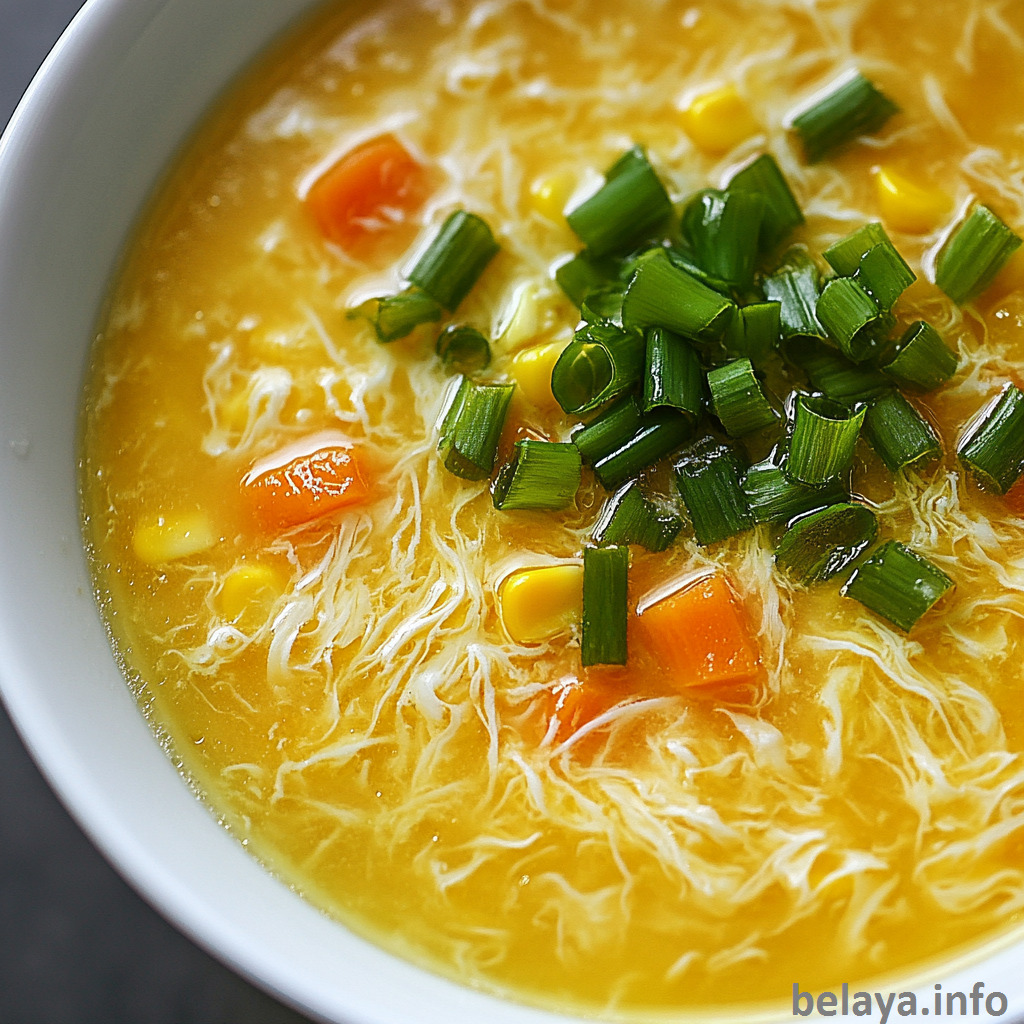
Important Notes When Making Egg Drop Soup:
Egg Texture Is Temperature-Dependent: The temperature of the broth at the time of egg addition is critical—too hot, and the eggs will overcook into chewy clumps; too cool, and they won’t set properly. Aim for a gentle simmer, not a rolling boil.
Order of Operations Matters: Always thicken the broth with the cornstarch slurry before adding the eggs. This allows the ribbons to form slowly and suspend elegantly in the slightly thickened soup, rather than sinking or dispersing.
Use a Steady Hand When Pouring Eggs: For beautiful, wispy strands, pour the eggs slowly in a thin, consistent stream. Rushing this step can result in dense egg clumps rather than delicate ribbons.
Turmeric Is Optional but Transformative: Just ¼ teaspoon of ground turmeric adds a subtle earthiness and a rich golden hue—enhancing both the visual and flavor appeal of the soup without overwhelming it.
Don’t Skip the Sesame Oil: This small addition added at the end enhances the soup’s aroma and rounds out the flavor with a warm, toasty finish. Use a good-quality toasted sesame oil for the best effect.
Garnish Thoughtfully: Fresh green onions not only add visual contrast but also a refreshing bite that lifts the richness of the broth—chop finely and sprinkle just before serving.
Serve Immediately: Egg Drop Soup is best enjoyed fresh, right after cooking. The delicate ribbons and glossy broth lose their texture and clarity upon reheating. If storing, keep components separate and reassemble quickly before serving.
How To Enjoy Egg Drop Soup After Cooking:
Let It Rest Briefly (1–2 Minutes):
Once removed from heat, give the soup a minute to settle. This allows the egg ribbons to fully set and the flavors to meld without overcooking.
Garnish Just Before Serving:
Top each bowl with freshly chopped green onions or even a dash of white pepper or chili oil, depending on your preference. These final touches enhance both aroma and presentation.
Serve Immediately, While Hot:
Egg Drop Soup is best enjoyed fresh. The silky egg ribbons and light broth are most flavorful and visually appealing right after cooking. Delaying serving can result in cloudiness or loss of texture.
Pair with Light Sides:
Enjoy the soup with steamed dumplings, spring rolls, or a bowl of jasmine rice for a balanced, comforting meal. It also pairs well with light stir-fried vegetables or grilled chicken.
Sip Slowly, Savor Fully:
This soup isn’t meant to be rushed. Savor each spoonful—the warmth, the silky eggs, and the layered flavors offer quiet comfort, especially during cold weather or when you’re under the weather.
Store Leftovers Mindfully (if needed):
If you must store leftovers, refrigerate in an airtight container for up to 2 days. Reheat gently over low heat, avoiding boiling, and stir slowly to preserve the egg texture. Note: the eggs may become slightly denser after reheating.
Optional Enhancements for Next Day:
For variety, you can reheat the soup and stir in a touch of miso paste, a splash of soy sauce, or even a few drops of chili oil to give it a new character while keeping its comforting core.
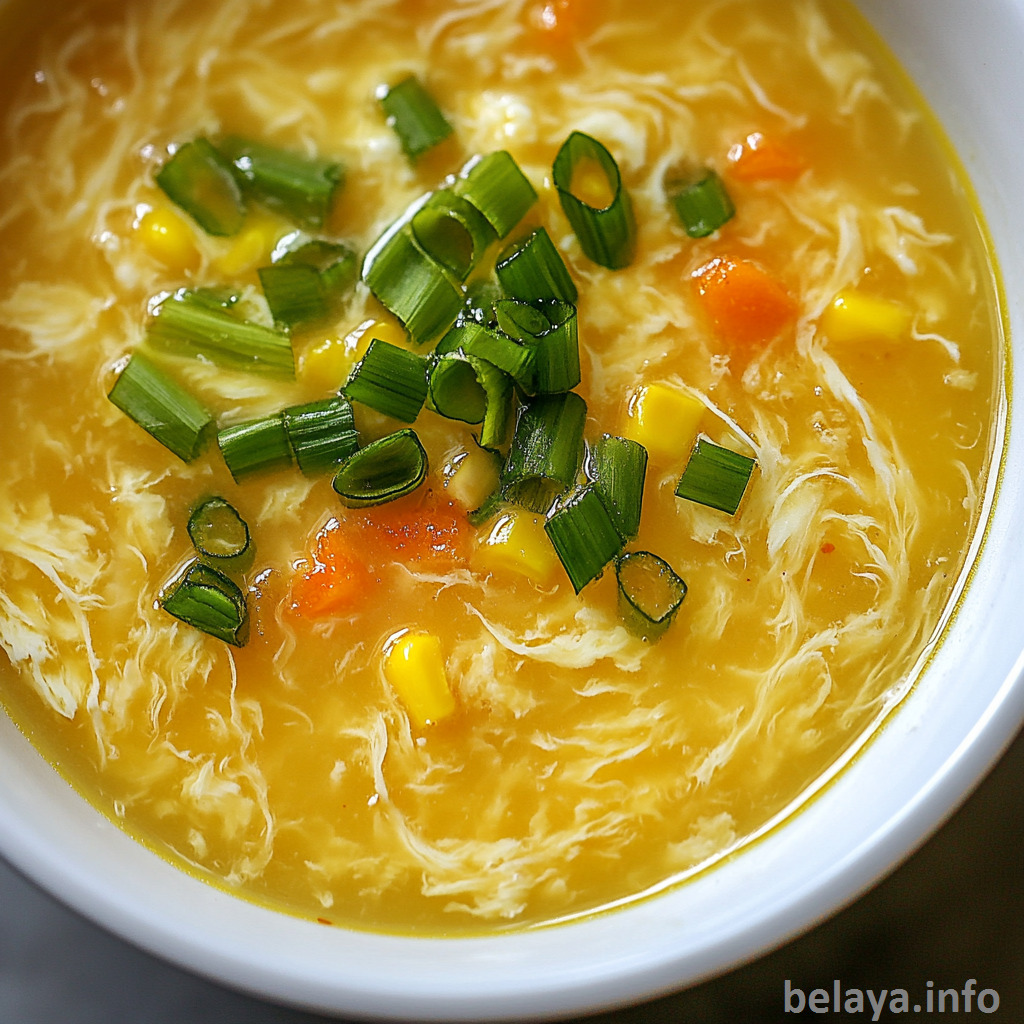
Nutrition Information per 1-cup (240ml) serving of Egg Drop Soup:
Calories: 80 kcal | Total Fat: 3.2 g | Saturated Fat: 0.8 g | Monounsaturated Fat: 1.2 g | Polyunsaturated Fat: 0.6 g | Cholesterol: 95 mg | Sodium: 400–550 mg (depending on broth and added salt) | Total Carbohydrates: 6.8 g | Dietary Fiber: 0.6 g | Sugars: 1.2 g | Protein: 6.5 g
Note: This estimate assumes standard chicken broth, 1 whole egg per serving, and mixed vegetables. Nutritional values may vary based on the type of broth, oil used, and exact portion sizes.

Frequently Asked Questions:
Why are my egg ribbons clumpy instead of wispy?
This usually happens when the broth is boiling too hard or the eggs are poured too quickly. For fine, silky ribbons, reduce the heat to a gentle simmer and pour the beaten eggs slowly in a thin stream while stirring the broth in one direction.
Can I make this soup vegetarian or vegan?
Yes. For a vegetarian version, use vegetable broth instead of chicken stock. For a vegan version, you’ll need to replace the eggs with a vegan egg substitute (like chickpea flour batter), though the texture and taste will differ from traditional egg ribbons.
How can I make the soup thicker?
Increase the amount of cornstarch slurry slightly (e.g., 3 tablespoons cornstarch with 3 tablespoons cold water), and add it gradually while stirring the soup until you reach your desired consistency.
What’s the best way to store and reheat leftovers?
Store cooled soup in an airtight container in the fridge for up to 2 days. Reheat gently over medium-low heat without bringing it to a boil, as high heat can cause the eggs to become rubbery.
Can I add extra protein or vegetables to make it more filling?
Absolutely. Add shredded chicken, tofu, mushrooms, spinach, or corn for added texture and nutrition. Just ensure any additions are fully cooked before incorporating them into the soup.
How do I prevent the eggs from overcooking in the soup?
Keep the broth at a gentle simmer (not a rolling boil) when adding the eggs. High heat can cause the eggs to seize and become rubbery instead of forming smooth, delicate ribbons.
Why is a cornstarch slurry important in this recipe?
The slurry slightly thickens the broth, helping the egg ribbons suspend beautifully instead of sinking or breaking apart. It also gives the soup a smooth, velvety texture that’s characteristic of restaurant-style egg drop soup.
Should I stir the soup while pouring in the eggs?
Yes, but stir gently in one direction to create a vortex, then slowly drizzle the eggs in a thin stream. This method helps form long, elegant ribbons instead of random clumps.
Can I substitute other starches for cornstarch?
Yes. Arrowroot powder or potato starch can be used in equal amounts. Avoid using flour, as it won’t give the same clear, glossy finish and can make the soup cloudy or gritty.
Do I need to temper the eggs before adding them?
No tempering is necessary. Simply beat the eggs well until uniform. The key is to pour them slowly into hot—but not boiling—broth while gently stirring to achieve perfect ribbons without curdling.